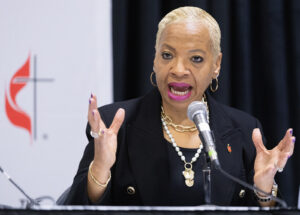
CHICAGO (BP)–At least one in four teenage girls in the United States has a sexually transmitted disease, amounting to 3.2 million youth, according to a first of its kind study by the Centers for Disease Control and Prevention released March 11.
About half of the girls admitted ever having sex, and among them, the rate of STD infection was 40 percent, researchers found. The highest overall prevalence was among black girls, with nearly half of them having an STD compared with 20 percent among whites and Mexican-American teenagers, the CDC said. Among the infected girls, 15 percent had more than one sexually transmitted disease.
“This study illustrates the need for continued emphasis and education on remaining sexually abstinent until marriage and then following God’s plan for sex to be enjoyed between one man and one woman in a marriage relationship,” Jimmy Hester, co-founder of the True Love Waits movement, told Baptist Press.
“The practice of early sexual activity with multiple partners carries with it many high and serious risks, and from this study we see just how prevalent the risks are,” Hester, senior director of student ministry publishing at LifeWay Church Resources, said. “Students practicing abstinence until marriage aren’t saddled with the weight of STDs and are able to live healthy, full and meaningful lives.”
The results come from data collected from 838 randomly selected girls age 14 to 19 who participated in a government health survey in 2003 and 2004. The teenagers were tested for HPV, which can cause cervical cancer and affected 18 percent of the girls studied; chlamydia, which affected 4 percent; trichomoniasis, which affected 2.5 percent; and herpes, which affected 2 percent, the Associated Press reported.
Allen Jackson, professor of youth ministry and director of the Youth Ministry Institute at New Orleans Baptist Theological Seminary, said Southern Baptists who read the statistics need to keep in mind their own children’s health could be at stake.
“Some in Southern Baptist life would be surprised that statistics on sexual activity are not significantly different between Christians and non-Christians,” Jackson said. “These kinds of findings point more to the need for parent and youth ministry involvement in authentic relationships and honest conversations with our students.”
AP noted that while some teenagers define sex as only intercourse, other types of behavior such as oral sex can spread some STDs.
Wendy Wright, president of Concerned Women for America, said public health officials need to admit that their failures have led to children paying the price.
“Funding irresponsible sex-ed programs — ones that encourage kids to be sexually active — 12 times higher than funding abstinence programs unsurprisingly results in more kids being sexually active,” Wright said in a statement following the study’s release.
“Experts note that a key prevention strategy is screening for STDs. Yet by making the morning-after pill available without a prescription, officials are discouraging young women from seeing a doctor when they are at risk of an STD.”
Valerie Huber, executive director of the National Abstinence Education Association, said, “[F]or too many years schools and communities have made reducing teen pregnancy the goal of sex education classes.”
“Teens are erroneously taught that a condom makes sex safe,” Huber said. “When we learn that one in four teen girls is infected with a sexually transmitted disease, it becomes clear that the contraception-based approach taught in 75 percent of U.S. schools is failing young people.
“The CDC study shows that the sexual health of teens should be paramount. The risk-avoidance message of abstinence education should be the top public health priority in response to this new information,” Huber added.
Wright voiced opposition to efforts at keeping parents in the dark when it comes to their children’s sexual practices.
“Parents are the best advocates for their kids, yet some doctors choose to put adolescents’ health at risk in order to keep medical information from their parents,” Wright said. “This negligence by doctors, driven by prejudice against parents, pretends to protect kids. However, it does worse than drive a wedge between parents and their children — it puts the teens’ lives and health at risk.”
Huber said a number of credible studies prove that teaching a wide range of character building, decision-making skills while also offering medically accurate information on STDs and contraception delays the onset of sexual activity among teenagers and reduces risky behavior among those already having sex.
“Teens deserve to know that condoms do not provide complete protection from STDs,” Huber said. “Parents and community leaders need to use the information from the CDC to begin an honest conversation with young people about the dangers of casual sex, and Congress must continue investing in abstinence education programs.”
Linda Klepacki, a sexual health analyst for Focus on the Family Action, said the abstinence message is being left out of the discussion at conferences such as the one in Chicago where the CDC results were released.
“With such high disease rates in teenagers, we’re just missing a tremendous opportunity to talk to them about the benefits of being abstinent until marriage,” Klepacki told Family News in Focus. “This is the time to teach kids about personal accountability and abstinence education. As it looks from this conference, the CDC is not grabbing that opportunity and taking it.”
Klepacki said that after the government funds education to assist children in becoming sexually active — what is known as comprehensive sex education — the taxpayers have to pay $15.5 billion more per year for health care to take care of STDs.
The CDC, in releasing the study, underscored the need to strengthen screening, vaccination and other prevention measures for the diseases. About 19 million new sexually transmitted infections occur yearly among all age groups in the United States, The New York Times noted.
“Instead of costly ‘screening, vaccination, and other prevention strategies,'” Hester told BP, “educating students, challenging them to make a commitment to abstain, and following up to support and encourage appropriate behavior should be our highest public health priority.”
Planned Parenthood, meanwhile, placed the blame for the high infection rates among teenage girls on abstinence programs, saying the study results “emphasize the need for real comprehensive sex education.”
“The national policy of promoting abstinence-only programs is a $1.5 billion failure, and teenage girls are paying the real price,” Cecile Richards, president of the Planned Parenthood Federation of America, told The Times.
The Food and Drug Administration has said condoms are “highly effective” at preventing infection by chlamydia, trichomoniasis, HIV, gonorrhea and hepatitis B, The Times reported, but the agency also said condoms are less effective against herpes and syphilis. Protection against HPV, the FDA said, “is partial at best” with condoms.
–30–
Erin Roach is a staff writer for Baptist Press.















